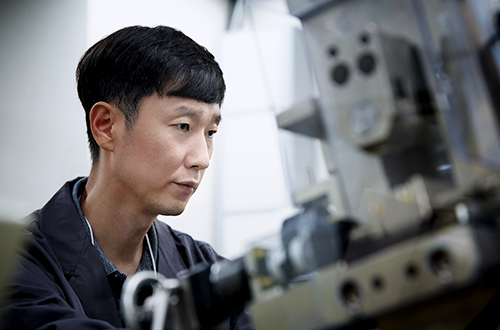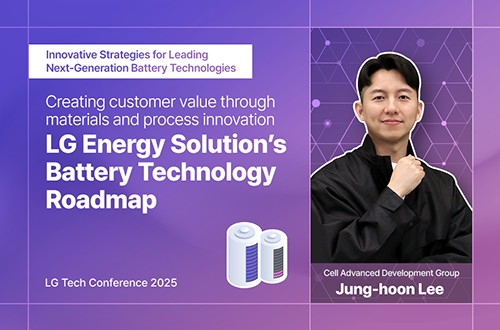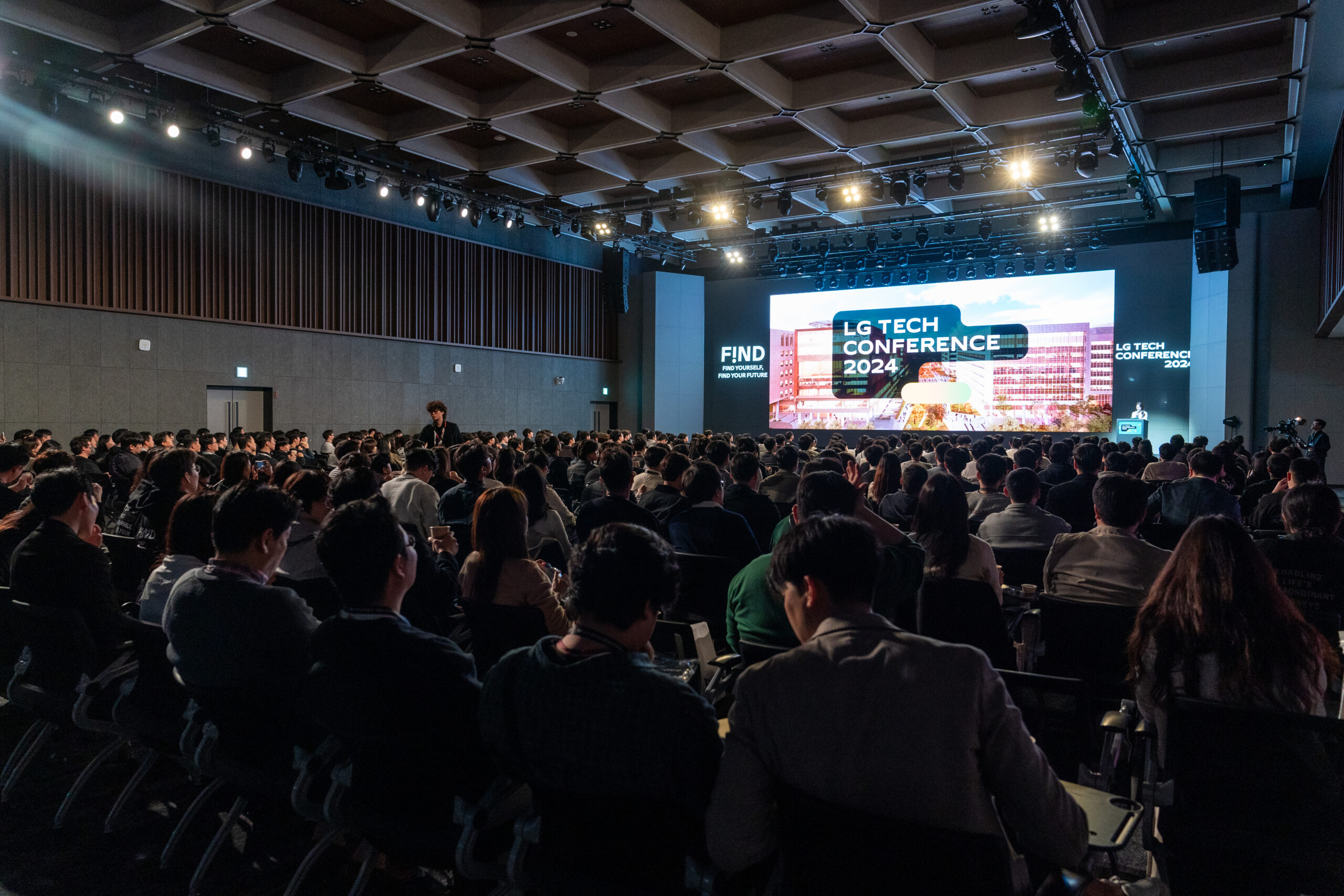
On April 4, about 300 Korean R&D researchers doing either a master’s or PhD course in university filled LG Sciencepark of the LG complex in Gangseo-gu, Seoul. They were attending the LG Tech Conference 2024 hosted there. The conference has invited talented Korean R&D researchers to provide a place to share next-generation technologies of LG Group, learn about the trends, and network with promising researchers since 2012.
This year, the conference showcased how LG is innovating to present differentiated customer value with technology development and its visions in a total of 40 technology sessions including big data, display, smart factory, robot, self-driving, and car battery. Among them, researchers took note of the secondary battery session where LG Energy Solution members told their own stories.
In this episode, we will have Jeong-hun Lee of the Electrolyte 2 Team in the Advanced Cell Development Center of LG Energy Solution and learn about the battery material technology of the future and the development trend of material technology.
Future Cathode Material Technology, Currently in the Limelight

LG Energy Solution classifies EVs into 3 segments: Premium, Standard, and Affordable, and develops batteries that fit for each of them.
First, the Premium line refers to high-performance EVs that demand the shortest charging time and offer the longest driving range on one charge. Those belonging to Standard and Affordable lines have relatively shorter driving range and require a longer charging time. However, they have price competitiveness. When the numbers of vehicles sold in a year are compared by the lines (Premium vs. Standard & Affordable), Standard and Affordable can be seen as the mainstream.
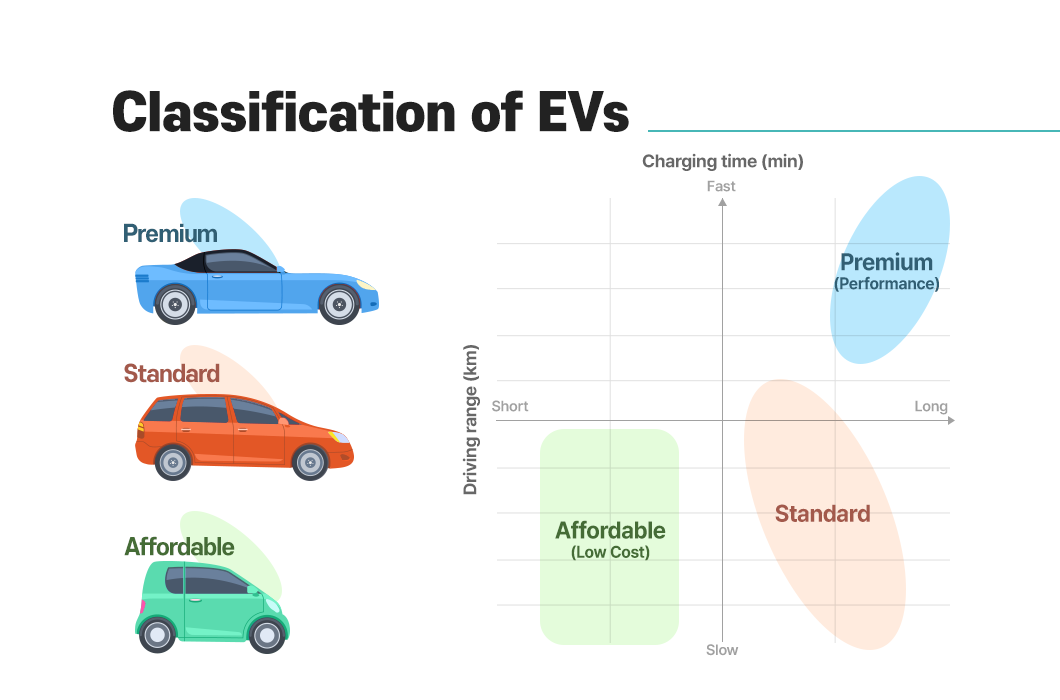
What needs to be considered in developing these segments? First comes safety, the most important value in EVs, and followed by “costs,” “charging time,” and “driving range” on one charge. Developing the 4 features to fit for the 3 segments is LG Energy Solution’s prowess.
How Far Has LG Energy Solution Developed Materials Technology?
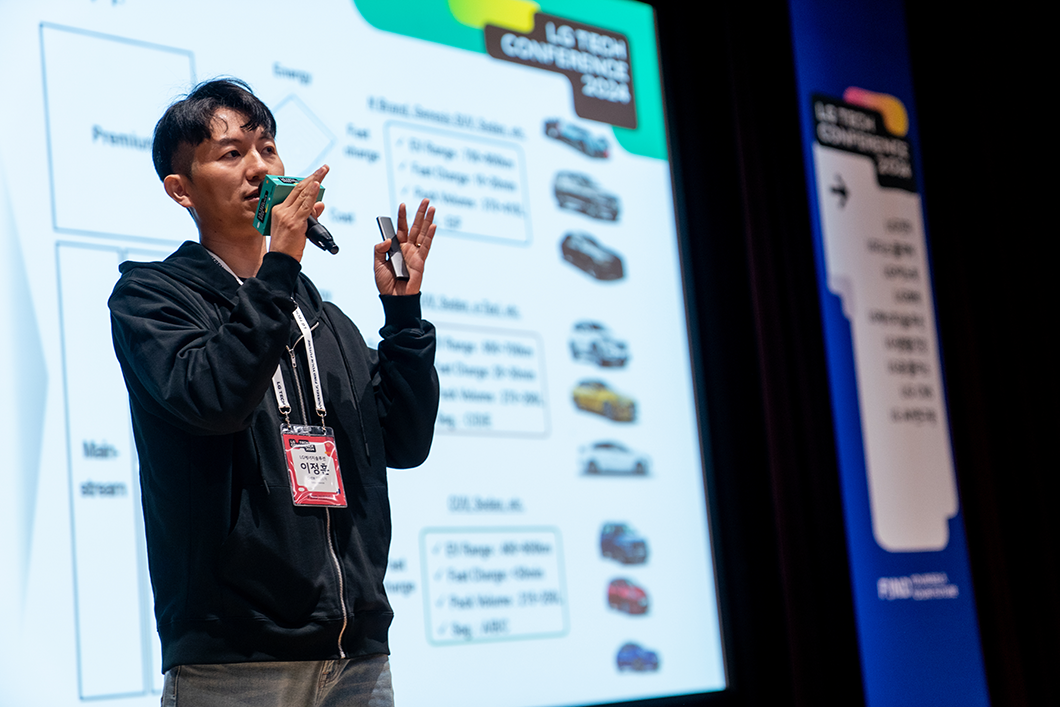
What are the battery material technologies that have been developed or will be developed to meet the requirements of the segments?
Reasons for Considering Various Cathode Materials
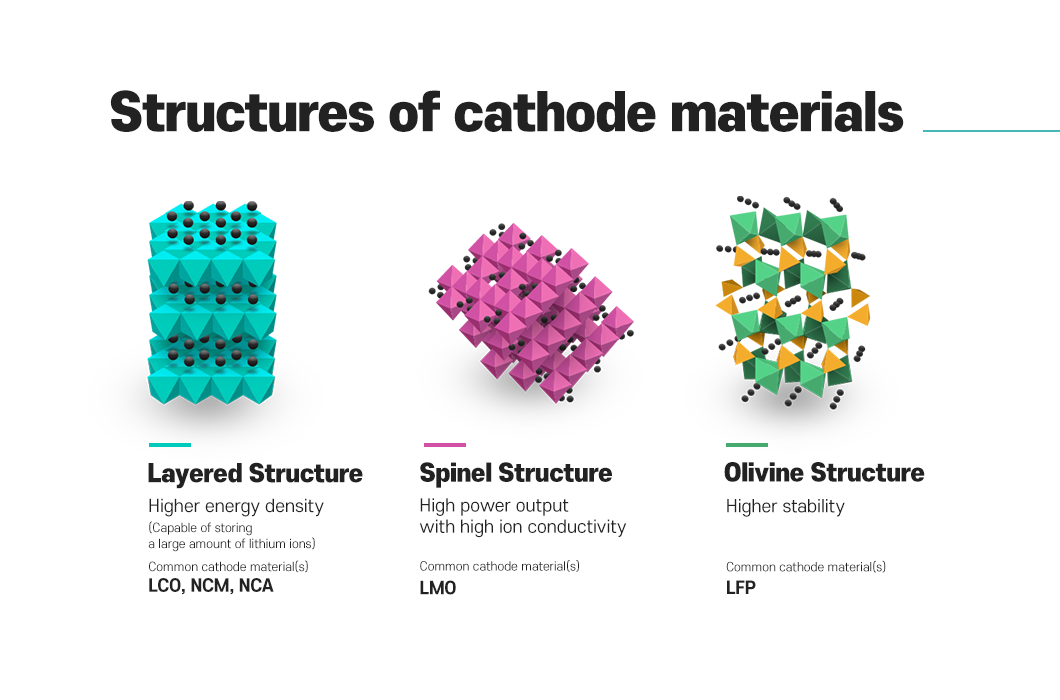
There are largely 3 types of cathode structures: Layered, spinel, and olivine. When evaluated for the 4 aspects of capacity, safety, output, and price, the layered NCM cathode material has an exceptional strength in capacity, and the spinel and olivine structures have price competitiveness since they do not need costly nickel and cobalt. LG Energy Solution employs all the different structures to cater to the different requirements of each segment.
So, the key of LG Energy Solution’s cathode material development is to build the right combination for the target segment first, and then to introduce the right technology, to create the optimum electrode status. By maximizing the strengths and making up for the weaknesses of batteries, it is boosting the power to move toward the future society.
Mid Nickel, a Favored Cathode Material for the “Standard”
You may have heard about “mid-nickel” a lot recently. This core material for the “Standard” EV lines has a lower nickel content of around 60%, and the reduced capacity accordingly is compensated for by high voltage. As the use of high voltage could undermine the durability, single crystal and coating technologies are used to limit the reactivity of active materials. When the technologies were actually applied, the cycle retention* improved and the amount of gas created in high temperature shrank remarkably.
* Cycle retention: A rate of retaining life cycle
LFP/LMFP, Commonly Used Materials for the “Affordable”
LFP is affordable since it does not contain costly nickel or cobalt. Also, the olivine structure makes it more stable than in the layered structure, even if lithium ions escape. However, the narrow range of working voltage restricts the amount of energy it can reserve and the small particle size adds difficulty in manufacturing electrodes. The energy issue of LFP can be alleviated by inserting manganese into it, and making it an LMFP. Still, application of manganese bolsters resistance, forcing the particles to shrink even more. Therefore, further research is necessary to overcome the shortage.
Mn-rich, a Post-LFP Material
Mn-rich is a material that has garnered attention as a solution to take care of the small capacity of LFP. This next-generation material is affordable because it does not contain expensive cobalt, but it has issues that need to be resolved such as gassing. Researchers are reviewing and developing ways to alter the shapes and sizes of particles and to control the surface, looking for diverse aspects for dealing with the problems.
High-Ni NCMA, the Choice for the “Premium”
High-Ni NCMA was produced with one of core technologies of LG Energy Solution. It is the most crucial material for the “Premium” EV line. LG Energy Solution has due reasons to be committed to developing this material despite the high price. It has a strong potential to become a flagship.
In the early times, High-Ni NCMA in the form of secondary particles was used. These days, however, single crystals are used to limit reactivity. Particle size is also considered important in the development of single particles, and research on various sizes is in progress. Accordingly, the packing density* of electrodes rises and the energy density of cells goes up as well. As such, the advantages of High-Ni are strengthened. Thermal stability of High-Ni NCMA is being increased much through coating technology or use of single crystals.
*Packing density: The ratio of the solid volume to the total volume
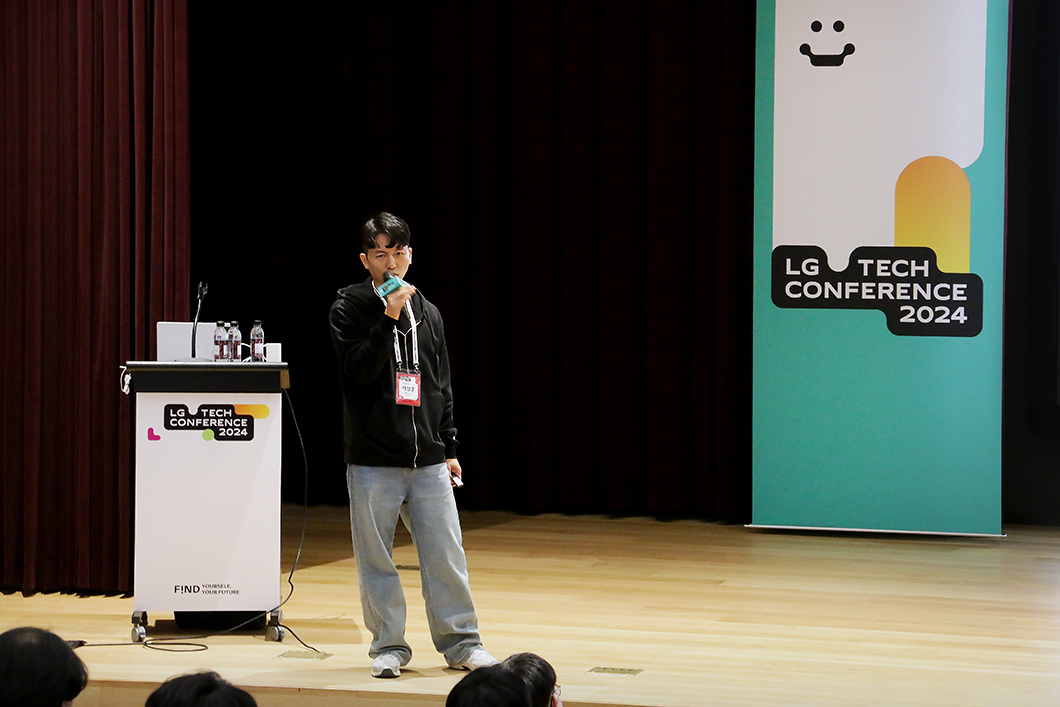
Anode Materials – Diversification of Silicon (Si) Materials
As for the anode, the most important thing is how to use silicon materials. Silicon has a large capacity, but its use is limited because it expands easily. Traditional silicon carbide powder offers high efficiency but has low cycle retention. SiO was produced using materials with higher active material durability for the purpose of improving cycle retention. The loss of efficiency caused by the irreversible SiO2 was made up for by metal doping, which also can improve both efficiency and durability at the same time.
The recent emphasis on silicon materials at LG Energy Solution is to develop a new type of SiC with a method that enables maintaining the advantages of SiC and SiO while reducing the disadvantages.
Separator – Evolution of SRS® Technology
Separators are made with the Safety Reinforced Separator (SRS®) technology, developed by LG Energy Solution single-handedly. This is a technology specialized for higher safety. Its ceramic layers enhance durability and it also has a feature that shuts down cells at high temperatures.
LG Energy Solution’s mass-production of its new SRS technology is imminent. And the plan is proceeding along with an innovation of the SRS manufacturing process. Many costs have been saved in the process, and the coating layer and binder layer were coated separately to ensure uniform coating quality. Such innovation made a thin separator possible.
A thinner separator shortens the distance lithium ions travel between the cathode and anode and significantly increases the output of the EV battery. If the coating layer is not maintained regularly, it gets thicker to compensate for the irregularity. Indeed, the technology that controls the thickness of coating layers regularly, brought the company closer to manufacturing the world’s best batteries.
Before, separators made with SRS technology sometimes shrank when exposed to a temperature of 180℃. When this happens, the separator cannot perform its primary role of keeping the cathode and anode apart physically. However, the new SRS of LG Energy Solution enables a high packing density, preventing any shrinkage of a separator even at the high temperature of 180℃. After all, the new technology pushed down prices, enhanced safety further, and raised the output.
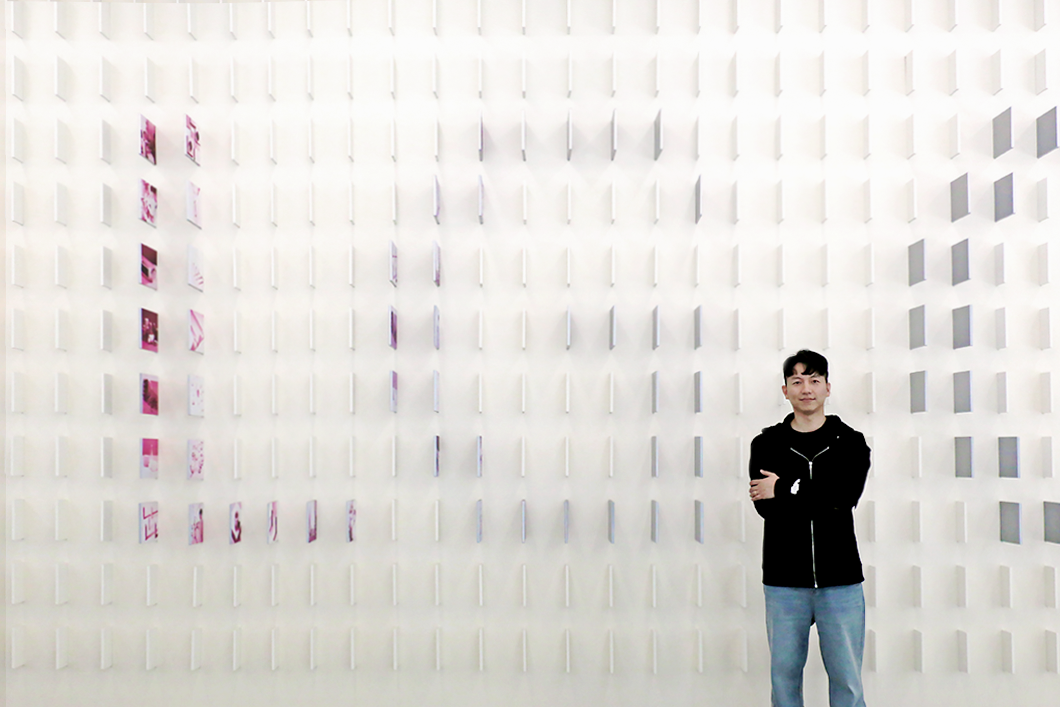
Electrolyte – Additives with Special Features and Higher Durability
The focus in developing electrolyte materials is to develop additives with special features and to adopt new solvents. Special additives are applied to improve the “acid safety” of electrolyte in case it meets the cathode. The additive currently being developed by LG Energy Solution caused formation of boron coating on the surface of the cathode and a remarkable drop in leakage currents in high voltage. The control of the surface and improvement in acid safety contributed to a plunge in the increase of resistance even when the voltage is kept high. Additionally, the gas that forms when the electrolyte and cathode come into contact was reduced.
Since the introduction of lithium-ion batteries, carbonate solvents have been used as an electrolyte material. To date, no solvent could have replaced them. These solvents have “sites” where gas occurs in their structure. If a solvent is designed to eliminate these sites in the first place, the formation of gas would also decrease.
So, we are developing a new solvent that suppresses gas formation by completely eliminating potential gas-forming sites in carbonate solvents. This is called “Gas-free solvent” technology. The technology for limiting side reactions is necessary to apply silicon material for the anode. Fluoro Ethylene Carbonate (FEC) has been thought to be the best additive to do the job. A new additive that is drawing attention recently forms polymer SEI as flexible as those formed with FEC additive and shows the same level of cycle performance*. It also resolved the gassing issue of FEC additives.
*Cycle Performance: Performance of life cycle
LG Energy Solution will stay committed to leading the battery industry by developing material technology, catering to our customers’ needs, and strengthening the technological edge.
